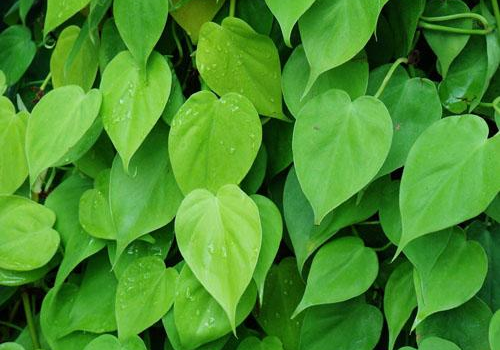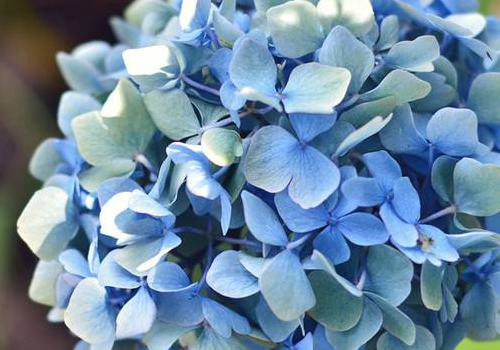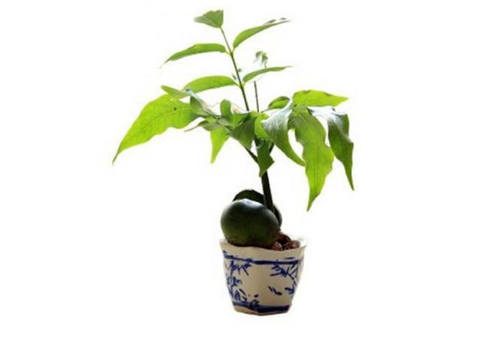Does the heart leaf vine purify the air? how to raise it?
Green plants or a lot of the role, but do not know the heart leaf rattan purify the air? How to raise:
Does the heart leaf vine purify air:
Heart leaf vine can purify the air. Heart leaf rattan is very suitable for decorating office places, shopping malls, hospitals, homes, conference places, office rooms, hotel lobbies, etc., in addition to beautifying the environment, greening decoration role, but also can purify the air, absorb harmful gases, more beneficial to human health.

How to raise the heart:
1, heart leaf rattan adaptability is strong, about 10℃ began to grow. To keep the soil moist, spray water on the plants when dry, cool them down, and keep the air humidity at 70% to 80%. However, if the temperature is below 15 ° C, the amount of watering needs to be reduced. In winter, keep it at about 5℃, and the basin soil should not be too damp.
2. May to September is the peak season for growth, and fertilizer is applied once or twice a month, mainly with decomposed thin organic liquid fertilizer. But not too much, otherwise the petiole will be long and weak, not easy to stand up, affecting the viewing effect. Apply sufficient base fertilizer when changing pots in spring.
3. The requirements for light are not strict. In summer, due to the high temperature, high temperature and high humidity, shade and ventilation should be strengthened. In autumn and winter, the temperature is low and the sun is full. The leaves will be yellow and green when the light is too strong, and the shade will be too long and lodging, which will affect the viewing effect.
Heart leaf vine is able to purify the air.
Philodendron scanaens Philodendron scanaens Cardium leaf vine is evergreen, fleshy vine, climbing sex is strong, height range: 1-3 meters. Heart leaf rattan shape characteristics heart leaf rattan dark green, evergreen fleshy vine, climbing strong, height range: 1-3 meters. The vine is asexual and does not flower. Heart leaf vine ecological habits heart leaf vine like semi-shade, like warm and humid climate, avoid sun exposure. The cultivation techniques of heart leaf rattan cultivation points heart leaf vine vine, climbing strong, heart-shaped dark green leaves, like warm and semi-sunny environment, but if long-term sunshine is easy to cause excessive growth of stem nodes affect the viewing effect. The soil should be decayed leaf soil with good drainage and slightly acidic. Thin fertilizer is watered once a month during the growing season. In winter, it is placed in front of the windowsill for maintenance. In spring and autumn, it can be placed in other places indoors. In summer, avoid direct sunlight. The fertilizer is mainly nitrogen fertilizer, which can be sprayed on leaves. Keep the soil moist and spray the foliage daily. After being cultivated and maintained properly, the heart leaf vine can be viewed for many years. Basin soil requirements loose soil is not easy to harden, available rotten leaf soil and vegetable soil each half mixed, or with sandy loam. When the old leaves at the bottom fall off and age, the old leaves can be cut off, so that it can re-extract the new leaves, and then climb along the direction of its own design, which can grow to 10 meters, and pruned in early March. Heartleaf vine grows fast and has higher requirements for fertilizer. It is better to apply more phosphorus and potassium fertilizer once or twice a month. Suitable for growth temperature of 15 degrees ~25 degrees, as long as 1 degree can be maintained safely through winter. The best time to cultivate Heart Leaf Rattan in hydroponic culture is from May to September. Cut 2~3 healthy stems and put them directly into a container with water. Be careful not to let the sun shine directly. The roots can be completed in about 20 days. Pay attention not to fertilize. Wait for the color of the roots to grow into green color. It is a new plant. The cultivation method of heart leaf rattan cultivation points sunlight, air, water, so indoor potted plants also need sunlight, and the amount of sunlight is only less than outdoor. Water can be kept slightly wet by touching the soil, watering once every 4 days. Liquid fertilizer is applied once every 14 days and can be absorbed by spraying on leaves. Place the plants in a suitable position, with good ventilation and light exposure. For feng shui, please refer to feng shui. Daily maintenance Regular wiping of the surface of the leaves, wiping off dust on the surface, can also keep the leaves fresh green. Regularly move plants to sunny areas, but avoid too much light changes, such as sunlight, window edges. When evergreen potted plants are just planted, it may take time to adapt. It is normal to lose leaves and yellow leaves. After adaptation, they will slowly recover to lush appearance. Therefore, at this time, do not arbitrarily sprinkle fertilizer or give too little or too much water. This makes it easier for plants to adapt to the environment. The propagation mode of heart leaf rattan commonly used cuttage, seeding, sub-plant and tissue culture propagation. Cuttage propagation is best from May to September. Cut 2~3 strong stems, insert them directly into coarse sand or water moss, keep them moist, keep the temperature at 22~24℃, and root 20~25 days after insertion. Sowing and propagation: Sowing in indoor seedling tray, germination temperature is 25%~30%, germination is 10~15 days after sowing, and the seedling height is 5~6 cm and moved to 8 cm pot. Plant propagation: When the plant grows higher, you can cut the lateral branches with aerial roots directly potted or first pick, promote how long branches, when the lateral branches are 15~20 cm, cut the potted plants with aerial roots. At present, in the United States, Israel, Australia and other countries, the use of tissue culture to reproduce large numbers of green velvet. Take stem apex or axillary bud as explant. After routine disinfection, the callus was inoculated on MS medium supplemented with 6-benzylaminoadenine 4 mg/l and indoleacetic acid 2 mg/l. Callus and adventitious buds grew after 6~8 weeks. Adventitious buds were transferred to 1/2MS medium supplemented with 2 mg/L indoleacetic acid, and new roots were induced in about 3~4 weeks. The distribution area of Celastrus cordifolius is adapted to: South China, South subtropical evergreen broad-leaved forest area (Main cities: Fuzhou, Xiamen, Quanzhou, Zhangzhou, Guangzhou, Foshan, Shunde, Dongguan, Huizhou, Shantou, Taipei, Liuzhou, Guiping, Gejiu) Tropical seasonal rain forest and rain forest area (Major cities: Haikou, Sanya, Qionghai, Kaohsiung, Tainan, Shenzhen, Zhanjiang, Zhongshan, Zhuhai, Macao, Hong Kong, Nanning, Qinzhou Beihai, Maoming, Jinghong) The role of ornamental value of the heart leaf rattan leaf similar to the heart named, vine, climbing strong, heart-shaped dark green leaves, is an elegant foliage plants. Purifying effect Heart leaf rattan in office places, shopping malls, hospitals, homes, conference places, offices, hotel lobbies, and other occasions used to beautify the environment, green decoration, purification of air and so on play a good role. The cultural background name of the heart leaf vine is derived from the heart leaf vine, also known as apricot leaf vine, because its leaves resemble hearts and get its name. Heart leaf vine flower language heart leaf vine flower language: quiet, warm. Flower astrology: can bring you sensitive heart and rich imagination, heart leaf rattan leaves quiet cool. How to water and fertilize the heart leaf vine
Many people like to raise green plants at home, which are beautiful and purify the air. How do you water your heart? How to fertilize:
How to Water the Heart:
Heart leaf vine green velvet likes high temperature and wet environment, must keep the basin soil moist, especially in summer can not lack water, but also often spray water to the leaves; but to avoid basin soil water, otherwise the leaves are easy to yellow. Generally, water once a day in spring and summer, and once every 3 to 5 days in autumn; in winter, the amount of watering should be reduced, but the pot soil cannot be completely dried.
How to apply fertilizer:
1, in the planting of heart leaf rattan need to use good drainage slightly acidic soil, at the same time need to apply some organic base fertilizer in the soil, so as to provide sufficient nutrition for its later growth and development.
2, when the heart leaf vine grows vigorously, generally in May to September, must pay attention to topdressing, but also do not need too much, generally one to two times a month to fertilize can, you can choose some water-soluble fertilizer, otherwise, its petiole will grow too long and soft, there is no standing effect, so it does not look good.
3, under normal circumstances, it is necessary to apply liquid fertilizer to the heart leaf vine once every half month, as long as the liquid fertilizer is sprayed on its leaves, so that the color of its leaves can be longer and greener, so that the overall shape is particularly beautiful, and the ornamental is greatly enhanced.
4, in the autumn is about to end and winter, heart leaf vine growth will become particularly slow, or even stop growing, this time can not be fertilized, otherwise it will break its dormant state, affecting its temperature rise when the growth.
Have you learned the conservation knowledge of heart leaf vine?
- Prev

When does Hydrangea blossom several times a year?
Hydrangea, which is also a super beautiful flower, can be adorable, so when will this hydrangea split? Blossom several times a year: when does Hydrangea split? the ramet time of Hydrangea should be carried out before sprouting in early spring. Separate the rooted branches from the mother plant and pot them directly, not too much watering.
- Next

How do green leaves grow yellow?
Green ingot is a form of ornamental plants, green ingot leaves yellow how to do? Planting precautions: green ingot leaves yellow how to do: 1, the reason: in the sun exposure. Green ingot likes cool and exposed growth environment, especially if it is placed in the house for a long time.
Related
- Fuxing push coffee new agricultural production and marketing class: lack of small-scale processing plants
- Jujube rice field leisure farm deep ploughing Yilan for five years to create a space for organic food and play
- Nongyu Farm-A trial of organic papaya for brave women with advanced technology
- Four points for attention in the prevention and control of diseases and insect pests of edible fungi
- How to add nutrient solution to Edible Fungi
- Is there any good way to control edible fungus mites?
- Open Inoculation Technology of Edible Fungi
- Is there any clever way to use fertilizer for edible fungus in winter?
- What agents are used to kill the pathogens of edible fungi in the mushroom shed?
- Rapid drying of Edible Fungi

